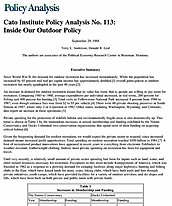Since World War II, the demand for outdoor recreation has increased tremendously. While the population has increased by 65 percent and real per capita income has approximately doubled,[l] overall participation in outdoor recreation has nearly quadrupled in the past 40 years.[2]
An increase in demand for outdoor recreation means that its value has risen; that is, people are willing to pay more for recreation. Comparing 1985 to 1960, average expenditures per individual increased, in real terms, 200 percent for fishing and 400 percent for hunting.[3] Total visits to Yellowstone National Park increased 8 percent from 1986 to 1987, even though entrance fees rose from $2 to $5 per vehicle.[4] There were 60 private shooting preserves in South Dakota in 1987, where only 3 or 4 operated in 1982. Other states, including Washington, Wyoming, and Colorado, also report an increase in these operations.[5]
Private spending for the protection of wildlife habitat and environmentally fragile areas is also dramatically up. This trend is shown in Table 1 by the tremendous increases in annual membership and funding exhibited by the Nature Conservancy and Ducks Unlimited, two conservation organizations that spend most of their funding on acquiring critical habitat.[6]
Given the burgeoning demand for outdoor recreation, we would expect the private sector to respond, since increased demand means increased profit opportunities. Total spending on outdoor recreation reached $100 billion in 1984.[7] A host of recreational product innovations have appeared in recent years in everything from electronic fishfinders to weather-resistant, featherweight clothing. Indeed, most private spending on recreation has been for equipment and travel.
Until very recently, a relatively small amount of private sector spending had been for inputs such as land, water, and other natural resources necessary for recreation. Exceptions to this trend include Kampgrounds of America, which was founded in 1962 as a response to a growing demand for camping facilities along major highways; hunting and fishing clubs in the East, which have leased lands for many years; hiking clubs, which have built trails and huts through private initiatives; youth camps, which have provided facilities for a variety of outdoor activities; and ski slopes and lifts, which have been built on both private and public lands with private funds.
The major reason there has not been more of a private supply response in the provision of natural resources has been competition from the public sector. With over 30 percent of the land owned by the federal government and the vast majority of this providing recreational opportunities, the private sector has found it difficult to compete. Much of the private response has occurred in the East, where federal land is less pervasive, or in the provision of facilities, such as ski runs and campgrounds, where additional capital investment is necessary. Recently, the private sector has responded in the West as overcrowding of free public resources has created more opportunities for entrepreneurs. Unfortunately, the large extent of public land ownership, combined with a long history of federal provision of recreational opportunities, creates an inertia that is difficult to overcome.
The recent President’s Commission on Americans Outdoors report provides an example of this public sector inertia. Charged with reviewing “outdoor recreation policies, programs and opportunities” for both the public and private sectors, the PCAO focused mostly on a single component of recreation: the federal “outdoor estate. H The dramatic proposals in the report could well set the stage for a vast expansion of public land ownership and federal controls on land use in the next two decades. They include a $15 billion trust fund, which would generate “an absolute minimum” of $1 billion to acquire, develop, and protect open space; a nationwide network of public greenways connecting existing and new parks, forests, and other open spaces; and finally, a scenic byways project that would require an expenditure of $200 million per year to protect scenic viewsheds along roadways through restrictive zoning. In the words of Conservation Foundation president William K. Reilly, the commission has “affirmed a crucial federal role in funding, leadership, and resource husbandry.”[8]
The recommendation that government take an even larger role in supplying recreation suggests that the private sector is unable to provide the optimal level of recreational services and resource husbandry for meeting the growing demand for outdoor recreation. PCAO recommendations imply that government is the best-qualified producer. A dismayed Jacqueline Schafer, a member of the President’s Council on Environmental Quality, points out that the commission does not emphasize people and the ways they create opportunities. She says the commission believes that “you can’t have [recreational] opportunity unless you have land guaranteed by the government.”[9]
Six important questions are raised regarding the provision of recreational opportunities: (1) What is the economics of outdoor recreation? (2) Is there market failure? (3) Why is there momentum for governmental provision? (4) Can the private sector respond? (5) What are the impediments to a private sector response? (6) Where do we go from here?
Answering these questions is critical to realizing the full potential of our outdoor resources. Private lands provide an important indication of this potential. These lands, after all, “constitute 60 percent of the 1.35 billion acres of America’s forests and rangelands.”[l0] Private lands contribute to our food, building, and energy supplies and provide a critical habitat for fish and wildlife as well as aesthetic and other environmental amenities.
Another reason for a critical economic analysis of recreation policy is that government often has proved negligent in caring for the land and water resources it controls. A growing list of travesties on public rangelands, forestlands, and waterways raises questions about whether government is the correct choice for resource stewardship.[ll] Equally impor- tant, a mounting federal debt is forcing us to seek ways to reduce the size of government and thus lessen the burden on the taxpayer. If the private sector can assume more of the responsibility for providing outdoor recreation, this burden can be reduced.
About the Authors

This work is licensed under a Creative Commons Attribution-NonCommercial-ShareAlike 4.0 International License.
